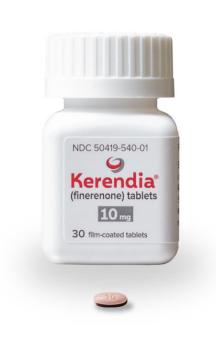Finerenone
Generic name: finerenone [ fin-ER-e-none ]
Brand name: Kerendia
Dosage form: oral tablet (10 mg; 20 mg)
Drug class: Aldosterone receptor antagonists
What is finerenone?
Finerenone is used in adults with chronic kidney disease related to diabetes mellitus type 2, to reduce the risk of:
-
kidney problems getting worse;
-
a heart attack;
-
needing to be hospitalized for heart failure; or
-
death from heart failure.
Finerenone may also be used for purposes not listed in this medication guide.
Finerenone side effects
Get emergency medical help if you have signs of an allergic reaction: hives; difficult breathing; swelling of your face, lips, tongue, or throat.
Finerenone may cause serious side effects. Call your doctor at once if you have:
-
high blood potassium--nausea, weakness, tingly feeling, chest pain, irregular heartbeats, loss of movement; or
-
low blood sodium--headache, confusion, problems with thinking or memory, weakness, feeling unsteady.
Common side effects of finerenone may include:
-
high potassium;
-
low sodium; or
This is not a complete list of side effects and others may occur. Call your doctor for medical advice about side effects. You may report side effects to FDA at 1-800-FDA-1088.
Warnings
Tell your doctor about all your other medicines. Some drugs should not be used with finerenone.
Before taking this medicine
You should not use finerenone if you are allergic to it, or if you have problems with your adrenal gland.
Some drugs should not be used with finerenone. Your treatment plan may change if you also use:
-
nefazodone;
-
an antibiotic--clarithromycin, telithromycin;
-
antifungal medicine--itraconazole, ketoconazole, posaconazole, voriconazole; or
-
antiviral medicine for HIV or hepatitis C--boceprevir, cobicistat, dasabuvir, elvitegravir, indinavir, lopinavir/ritonavir, nelfinavir, ombitasvir, paritaprevir saquinavir, telaprevir, tipranavir.
Tell your doctor if you have ever had:
-
severe liver disease; or
-
high blood levels of potassium (hyperkalemia).
It is not known if finerenone will harm an unborn baby. Tell your doctor if you are pregnant or plan to become pregnant.
You should not breastfeed while using finerenone, and for at least 1 day after your last dose.
Not approved for use by anyone younger than 18 years old.
How should I take finerenone?
Follow all directions on your prescription label and read all medication guides or instruction sheets. Your doctor may occasionally change your dose. Use the medicine exactly as directed.
You may take finerenone with or without food.
If you cannot swallow a tablet whole, crush the tablet and mix it with water or soft food such as applesauce. Swallow the mixture right away.
You will need medical tests.
Store at room temperature away from moisture and heat.
Finerenone dosing information
Usual Adult Dose for Chronic Kidney Disease:
Initial dose:
-For estimated glomerular filtration rate (eGFR) at least 60 mL/min/1.73 m2: 20 mg orally once a day
-For eGFR 25 to less than 60 mL/min/1.73 m2: 10 mg orally once a day
Target dose: 20 mg orally once a day
Comments:
-Initiation of therapy is not recommended if serum potassium is greater than 5 mEq/L; if serum potassium levels are greater than 4.8 to 5 mEq/L, initiation of therapy may be considered with additional serum potassium monitoring within the first 4 weeks based on clinical judgment and serum potassium levels.
-Initiation of therapy is not recommended in patients with eGFR less than 25 mL/min/1.73 m2.
Use: To reduce the risk of sustained eGFR decline, end-stage kidney disease, cardiovascular death, nonfatal myocardial infarction, and hospitalization for heart failure in patients with chronic kidney disease associated with type 2 diabetes
What happens if I miss a dose?
Take the missed dose on the same day you remember it. Take your next dose at the regular time and stay on your once-daily schedule. Do not take 2 doses in one day.
What happens if I overdose?
Seek emergency medical attention or call the Poison Help line at 1-800-222-1222.
What should I avoid while taking finerenone?
Do not take potassium supplements or use salt substitutes, unless your doctor has told you to.
Grapefruit may interact with finerenone and cause side effects. Avoid consuming grapefruit products.
What other drugs will affect finerenone?
Many drugs can affect finerenone, and some drugs should not be used at the same time. Tell your doctor about all other medicines you use. This includes prescription and over-the-counter medicines, vitamins, and herbal products. Not all possible interactions are listed here.
More about finerenone
- Check interactions
- Compare alternatives
- Reviews (2)
- Side effects
- Dosage information
- During pregnancy
- Drug class: aldosterone receptor antagonists
- Breastfeeding
- En español
Patient resources
Other brands
Professional resources
Other brands
Related treatment guides
Further information
Remember, keep this and all other medicines out of the reach of children, never share your medicines with others, and use this medication only for the indication prescribed.
Always consult your healthcare provider to ensure the information displayed on this page applies to your personal circumstances.
Copyright 1996-2024 Cerner Multum, Inc. Version: 1.01.

